child restraint MERCEDES-BENZ B-CLASS HATCHBACK 2014 Owners Manual
[x] Cancel search | Manufacturer: MERCEDES-BENZ, Model Year: 2014, Model line: B-CLASS HATCHBACK, Model: MERCEDES-BENZ B-CLASS HATCHBACK 2014Pages: 405, PDF Size: 12.24 MB
Page 9 of 405
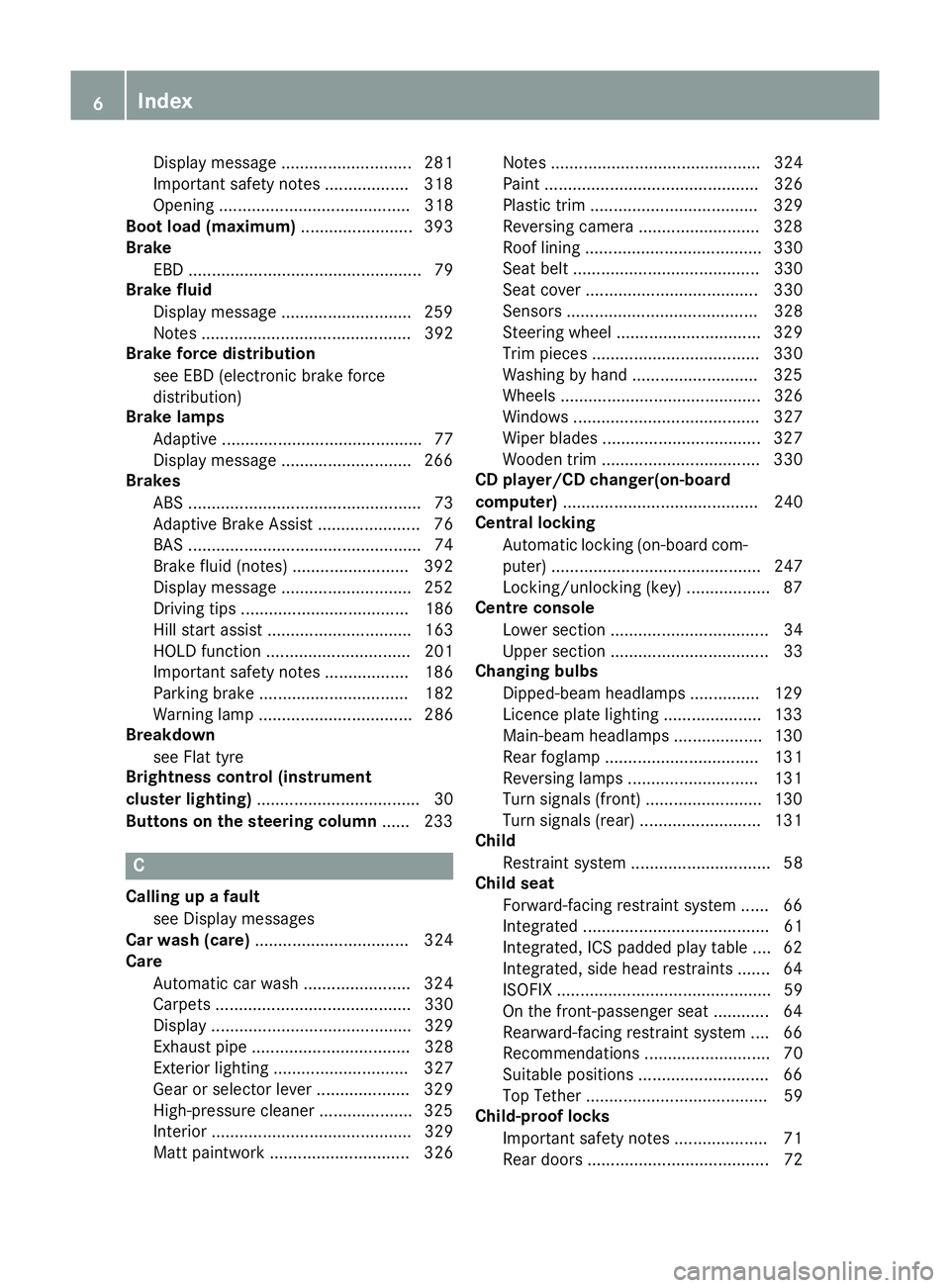
Display message ............................ 281
Important safety note s.................. 318
Opening ......................................... 318
Boot load (maximum) ........................ 393
Brake
EBD .................................................. 79
Brake fluid
Display message ............................ 259
Notes ............................................. 392
Brake force distribution
see EBD (electronic brake force
distribution)
Brake lamps
Adaptive ........................................... 77
Display message ............................ 266
Brakes
ABS .................................................. 73
Adaptive Brake Assist ...................... 76
BAS .................................................. 74
Brake fluid (notes) ......................... 392
Display message ............................ 252
Driving tips .................................... 186
Hill start assist ............................... 163
HOLD function ............................... 201
Important safety notes .................. 186
Parking brake ................................ 182
Warning lamp ................................. 286
Breakdown
see Flat tyre
Brightness control (instrument
cluster lighting) ................................... 30
Buttons on the steering column ...... 233C
Calling up a fault see Display messages
Car wash (care) ................................. 324
Care
Automatic car wash ....................... 324
Carpets .......................................... 330
Display ........................................... 329
Exhaust pipe .................................. 328
Exterior lighting ............................. 327
Gear or selector lever .................... 329
High-pressure cleaner .................... 325
Interior ........................................... 329
Matt paintwork .............................. 326 Note
s............................................. 324
Paint .............................................. 326
Plastic trim .................................... 329
Reversing camera .......................... 328
Roof lining ...................................... 330
Seat belt ........................................ 330
Seat cove r..................................... 330
Sensors ......................................... 328
Steering wheel ............................... 329
Trim pieces .................................... 330
Washing by hand ........................... 325
Wheels ........................................... 326
Windows ........................................ 327
Wiper blades .................................. 327
Wooden trim .................................. 330
CD player/CD changer(on-board
computer) .......................................... 240
Central locking
Automatic locking (on-board com-puter) ............................................. 247
Locking/unlocking (key) .................. 87
Centre console
Lower section .................................. 34
Upper section .................................. 33
Changing bulbs
Dipped-beam headlamp s............... 129
Licence plate lighting ..................... 133
Main-beam headlamp s................... 130
Rear foglamp ................................. 131
Reversing lamps ............................ 131
Turn signals (front) ......................... 130
Turn signals (rear) .......................... 131
Child
Restraint system .............................. 58
Child seat
Forward-facing restraint system ...... 66
Integrated ........................................ 61
Integrated, ICS padded play table .... 62
Integrated, side head restraints ....... 64
ISOFIX .............................................. 59
On the front-passenger seat ............ 64
Rearward-facing restraint system .... 66
Recommendations ........................... 70
Suitable positions ............................ 66
Top Tether ....................................... 59
Child-proof locks
Important safety notes .................... 71
Rear doors ....................................... 72 6
Index
Page 14 of 405
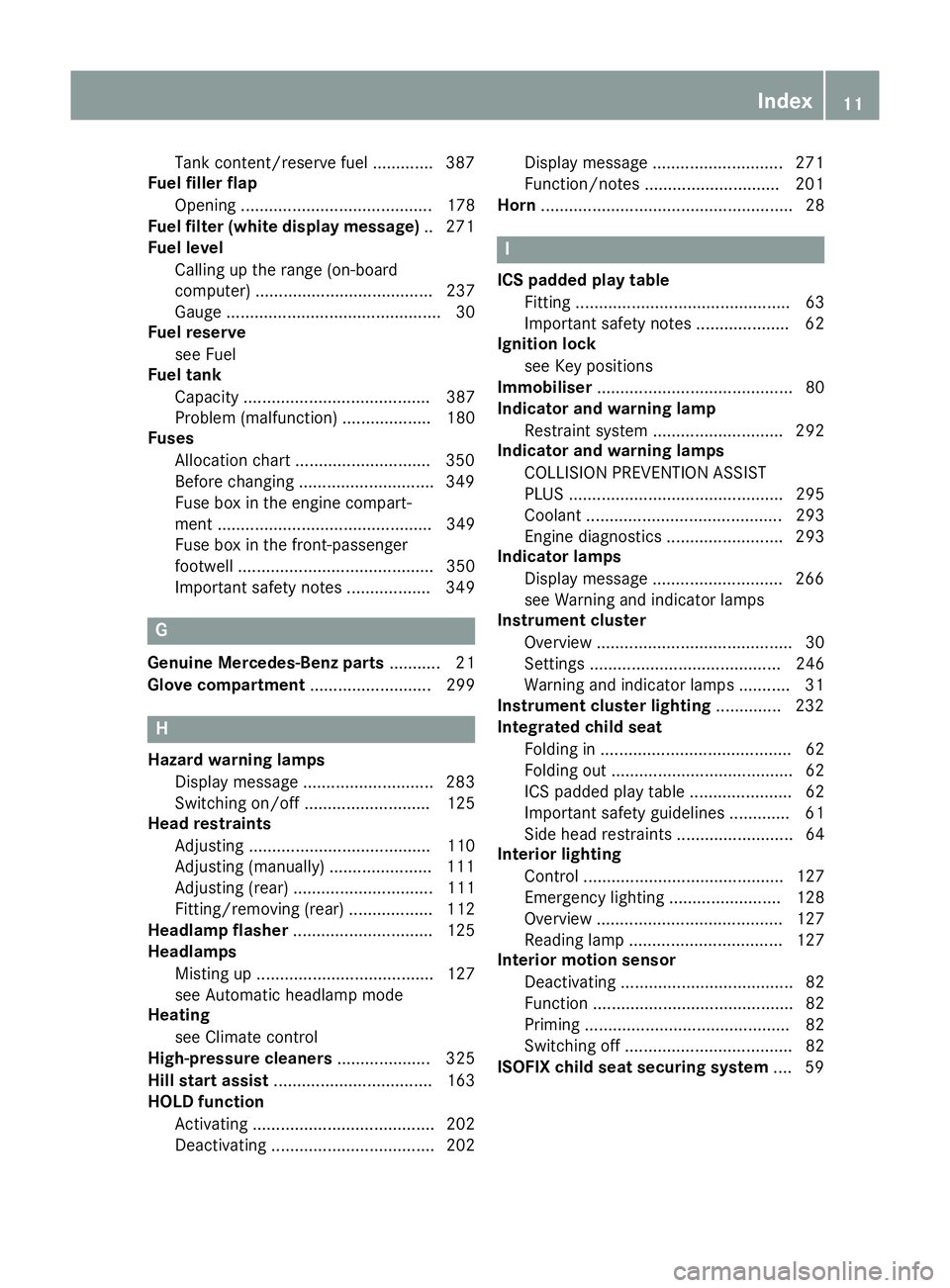
Tank content/reserve fuel .............3
87
Fuel filler flap
Opening ......................................... 178
Fuel filter (white display message) .. 271
Fuel level
Calling up the range (on-board
computer) ...................................... 237
Gauge .............................................. 30
Fuel reserve
see Fuel
Fuel tank
Capacity ........................................ 387
Problem (malfunction) ................... 180
Fuses
Allocation chart ............................ .350
Before changing ............................ .349
Fuse box in the engine compart-
ment .............................................. 349
Fuse box in the front-passenger
footwell .......................................... 350
Important safety notes .................. 349 G
Genuine Mercedes-Benz parts ........... 21
Glove compartment .......................... 299H
Hazard warning lamps Display message ............................ 283
Switching on/off ........................... 125
Head restraints
Adjusting ....................................... 110
Adjusting (manually) ..................... .111
Adjusting (rear) .............................. 111
Fitting/removing (rear) .................. 112
Headlamp flasher .............................. 125
Headlamps
Misting up ...................................... 127
see Automatic headlamp mode
Heating
see Climate control
High-pressure cleaners .................... 325
Hill start assist .................................. 163
HOLD function
Activating ....................................... 202
Deactivating ................................... 202 Display message ............................ 271
Function/notes ............................
.201
Horn ...................................................... 28 I
ICS padded play table Fitting .............................................. 63
Important safety notes .................... 62
Ignition lock
see Key positions
Immobiliser .......................................... 80
Indicator and warning lamp
Restraint system ............................ 292
Indicator and warning lamps
COLLISION PREVENTION ASSIST
PLUS .............................................. 295
Coolant .......................................... 293
Engine diagnostics ......................... 293
Indicator lamps
Display message ............................ 266
see Warning and indicator lamps
Instrument cluster
Overview .......................................... 30
Settings ......................................... 246
Warning and indicator lamps ........... 31
Instrument cluster lighting .............. 232
Integrated child seat
Folding in ......................................... 62
Folding out ....................................... 62
ICS padded play tabl e...................... 62
Important safety guidelines ............. 61
Side head restraints ......................... 64
Interior lighting
Control ........................................... 127
Emergency lighting ........................ 128
Overview ........................................ 127
Reading lamp ................................. 127
Interior motion sensor
Deactivating ..................................... 82
Function ........................................... 82
Priming ............................................ 82
Switching off .................................... 82
ISOFIX child seat securing system .... 59 Index
11
Page 16 of 405
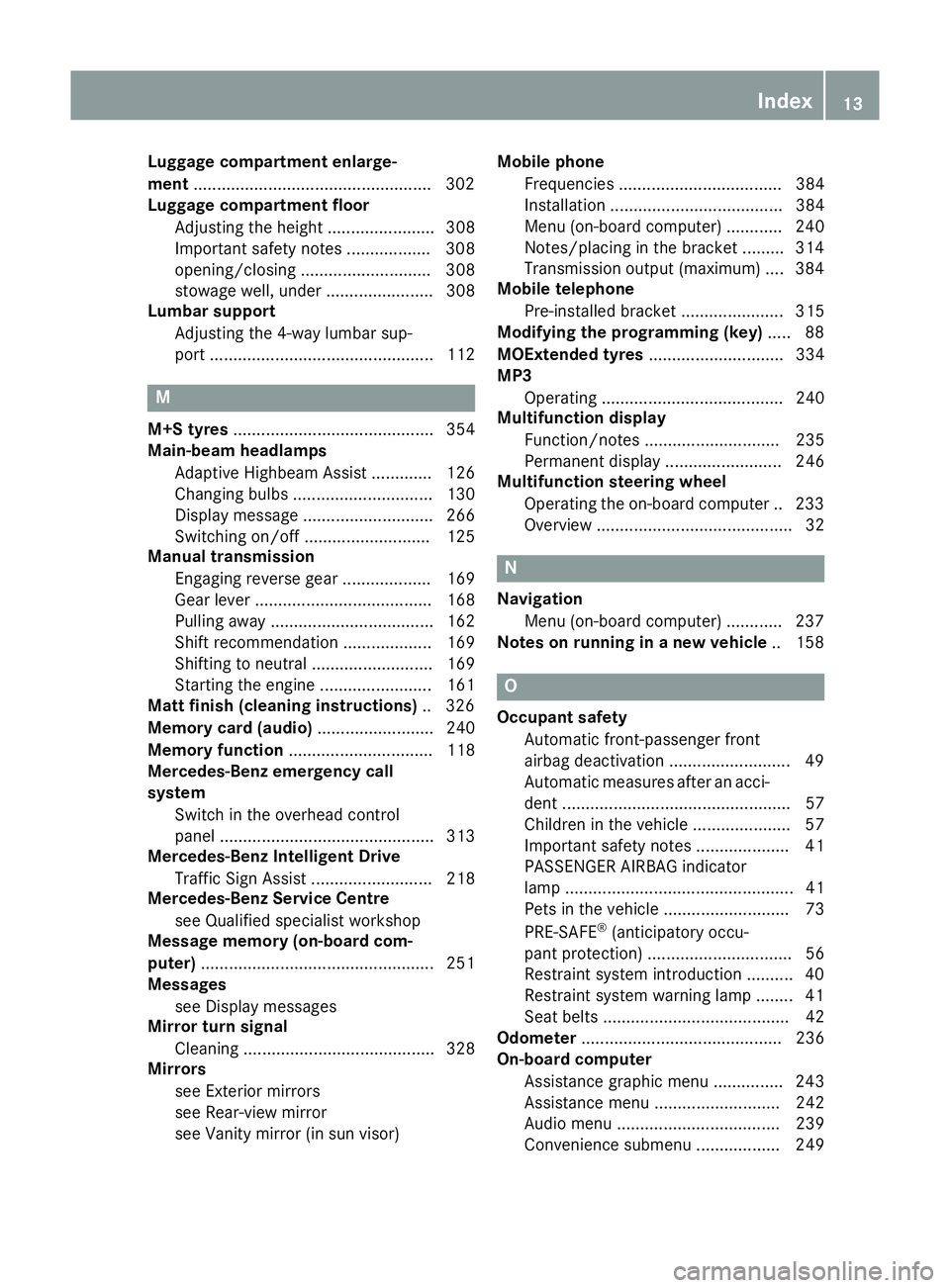
Luggage compartment enlarge-
ment
.................................................. .302
Luggage compartment floor
Adjusting the height ....................... 308
Important safety notes .................. 308
opening/closing ............................ 308
stowage well, unde r....................... 308
Lumbar support
Adjusting the 4-way lumbar sup-
port ................................................ 112 M
M+S tyres ........................................... 354
Main-beam headlamps
Adaptive Highbeam Assist ............. 126
Changing bulb s.............................. 130
Display message ............................ 266
Switching on/of f........................... 125
Manual transmission
Engaging reverse gear ................... 169
Gear lever ...................................... 168
Pulling away ................................... 162
Shift recommendation ................... 169
Shifting to neutral .......................... 169
Starting the engine ........................ 161
Matt finish (cleaning instructions) .. 326
Memory card (audio) ......................... 240
Memory function ............................... 118
Mercedes-Benz emergency call
system
Switch in the overhead control
panel .............................................. 313
Mercedes-Benz Intelligent Drive
Traffic Sign Assist .......................... 218
Mercedes-Benz Service Centre
see Qualified specialist workshop
Message memory (on-board com-
puter) .................................................. 251
Messages
see Display messages
Mirror turn signal
Cleaning ......................................... 328
Mirrors
see Exterior mirrors
see Rear-view mirror
see Vanity mirror (in sun visor) Mobile phone
Frequencies ................................... 384
Installation ..................................... 384
Menu (on-board computer) ............ 240
Notes/placing in the bracket ......... 314
Transmission output (maximum) .... 384
Mobile telephone
Pre-installed bracket ...................... 315
Modifying the programming (key) ..... 88
MOExtended tyres ............................. 334
MP3
Operating ....................................... 240
Multifunction display
Function/note s............................. 235
Permanent display ......................... 246
Multifunction steering wheel
Operating the on-board compute r..2 33
Overview .......................................... 32 N
Navigation Menu (on-board computer) ............ 237
Notes on running in a new vehicle .. 158 O
Occupant safety Automatic front-passenger front
airbag deactivatio n .......................... 49
Automatic measures after an acci-
dent ................................................. 57
Children in the vehicle ..................... 57
Important safety notes .................... 41
PASSENGER AIRBAG indicator
lamp ................................................. 41
Pets in the vehicle ........................... 73
PRE-SAFE ®
(anticipatory occu-
pant protection) ............................... 56
Restraint system introduction .......... 40
Restraint system warning lamp ....... .41
Seat belts ........................................ 42
Odometer ........................................... 236
On-board computer
Assistance graphic menu ............... 243
Assistance menu ........................... 242
Audio menu ................................... 239
Convenience submenu .................. 249 Index
13
Page 19 of 405
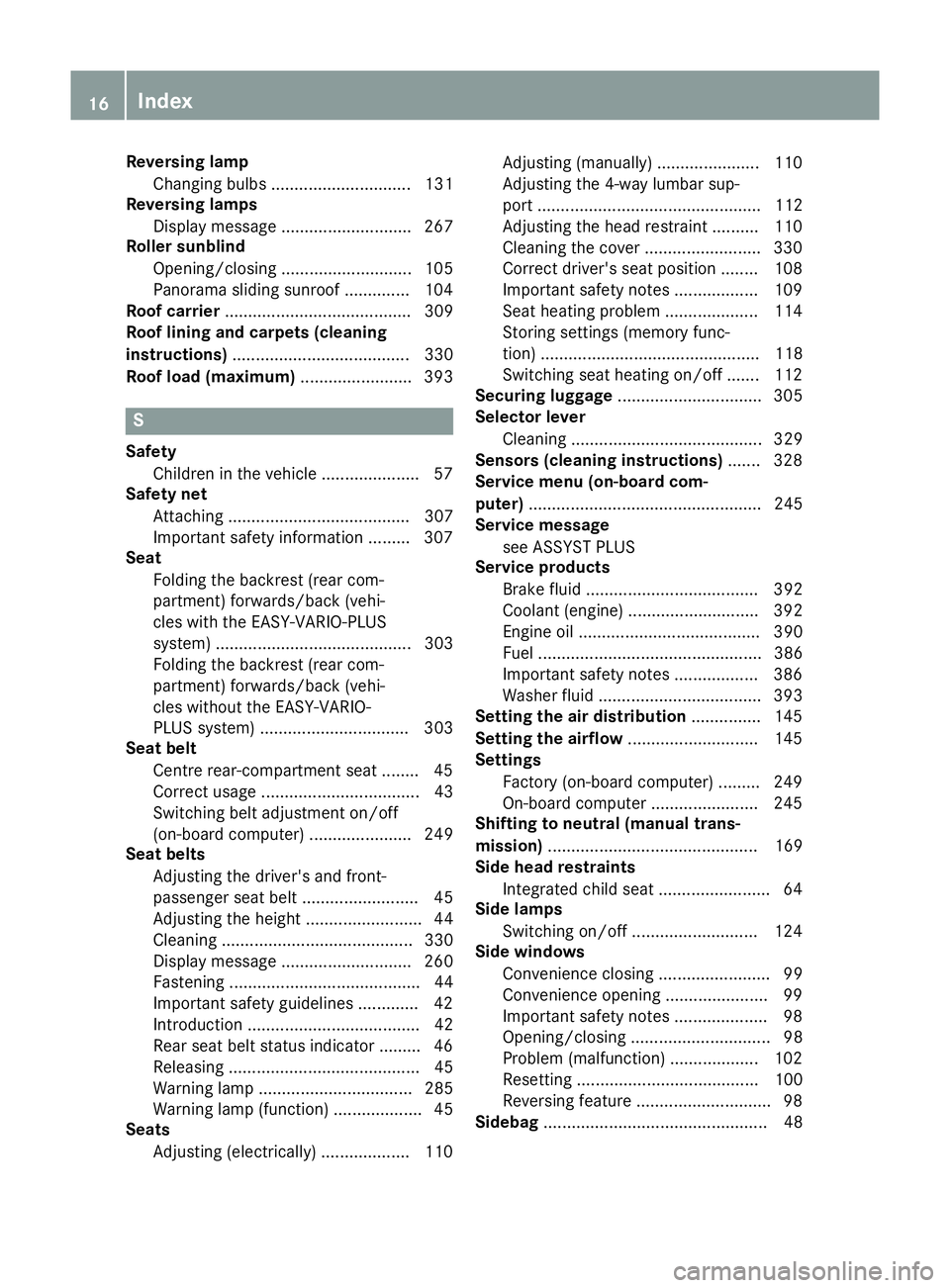
Reversing lamp
Changing bulb s.............................. 131
Reversing lamps
Display message ............................ 267
Roller sunblind
Opening/closing ............................ 105
Panorama sliding sunroof .............. 104
Roof carrier ........................................ 309
Roof lining and carpets (cleaning
instructions) ...................................... 330
Roof load (maximum) ........................ 393S
Safety Children in the vehicle ..................... 57
Safety net
Attaching ....................................... 307
Important safety information ......... 307
Seat
Folding the backrest (rear com-
partment) forwards/back (vehi-
cles with the EASY-VARIO-PLUS
system) .......................................... 303
Folding the backrest (rear com-
partment) forwards/back (vehi-
cles without the EASY-VARIO-
PLUS system) ................................ 303
Seat belt
Centre rear-compartment sea t........ 45
Correct usage .................................. 43
Switching belt adjustment on/off
(on-board computer) ...................... 249
Seat belts
Adjusting the driver's and front-
passenger seat belt ......................... 45
Adjusting the height ......................... 44
Cleaning ......................................... 330
Display message ............................ 260
Fastening ......................................... 44
Important safety guidelines ............. 42
Introduction ..................................... 42
Rear seat belt status indicator ......... 46
Releasing ......................................... 45
Warning lamp ................................. 285
Warning lamp (function) ................... 45
Seats
Adjusting (electrically) ................... 110 Adjusting (manually) ...................... 110
Adjusting the 4-way lumbar sup-
port ................................................ 112
Adjusting the head restraint .......... 110
Cleaning the cover ......................... 330
Correct driver's seat position ........ 108
Important safety notes .................. 109
Seat heating problem .................... 114
Storing settings (memory func-
tion) ............................................... 118
Switching seat heating on/of
f....... 112
Securing luggage ............................... 305
Selector lever
Cleaning ......................................... 329
Sensors (cleaning instructions) ....... 328
Service menu (on-board com-
puter) .................................................. 245
Service message
see ASSYST PLUS
Service products
Brake fluid ..................................... 392
Coolant (engine) ............................ 392
Engine oil ....................................... 390
Fuel ................................................ 386
Important safety notes .................. 386
Washer fluid ................................... 393
Setting the air distribution ............... 145
Setting the airflow ............................ 145
Settings
Factory (on-board computer) ......... 249
On-board compute r....................... 245
Shifting to neutral (manual trans-
mission) ............................................. 169
Side head restraints
Integrated child seat ........................ 64
Side lamps
Switching on/of f........................... 124
Side windows
Convenience closing ........................ 99
Convenience opening ...................... 99
Important safety notes .................... 98
Opening/closing .............................. 98
Problem (malfunction) ................... 102
Resetting ....................................... 100
Reversing feature ............................. 98
Sidebag ................................................ 48 16
Index
Page 43 of 405
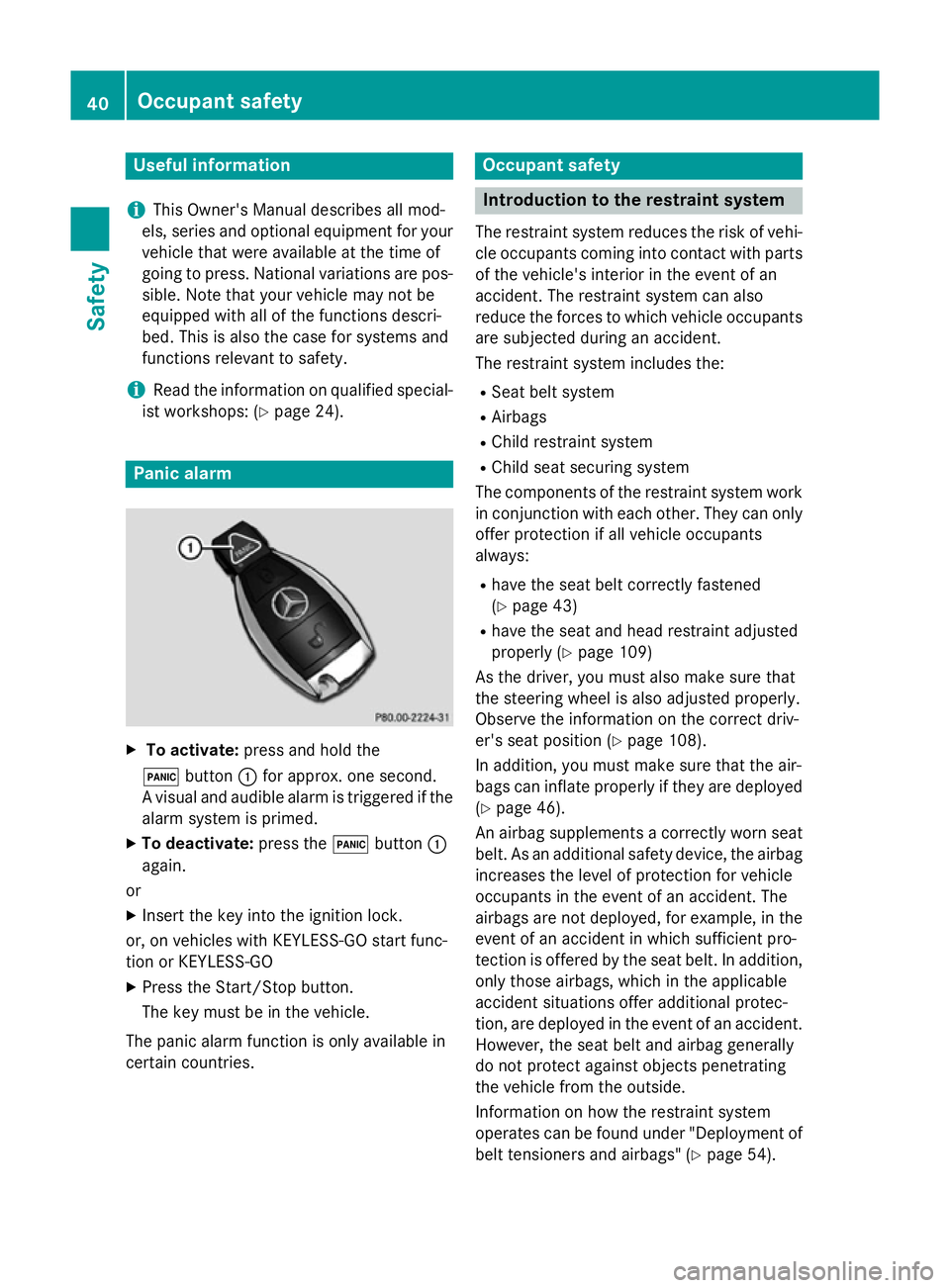
Useful information
i This Owner's Manual describes all mod-
els, series and optional equipment for your
vehicle that were available at the time of
going to press. National variations are pos- sible. Note that your vehicle may not be
equipped with all of the functions descri-
bed. This is also the case for systems and
functions relevant to safety.
i Read the information on qualified special-
ist workshops: (Y page 24). Panic alarm
X
To activate: press and hold the
! button :for approx. one second.
A visual and audible alarm is triggered if the alarm system is primed.
X To deactivate: press the!button :
again.
or
X Insert the key into the ignition lock.
or, on vehicles with KEYLESS-GO start func-
tion or KEYLESS ‑GO
X Press the Start/Stop button.
The key must be in the vehicle.
The panic alarm function is only available in
certain countries. Occupant safety
Introduction to the restraint system
The restraint system reduces the risk of vehi- cle occupants coming into contact with parts
of the vehicle's interior in the event of an
accident. The restraint system can also
reduce the forces to which vehicle occupants
are subjected during an accident.
The restraint system includes the:
R Seat belt system
R Airbags
R Child restraint system
R Child seat securing system
The components of the restraint system work
in conjunction with each other. They can only
offer protection if all vehicle occupants
always:
R have the seat belt correctly fastened
(Y page 43)
R have the seat and head restraint adjusted
properly (Y page 109)
As the driver, you must also make sure that
the steering wheel is also adjusted properly.
Observe the information on the correct driv-
er's seat position (Y page 108).
In addition, you must make sure that the air-
bags can inflate properly if they are deployed (Y page 46).
An airbag supplements a correctly worn seat belt. As an additional safety device, the airbag
increases the level of protection for vehicle
occupants in the event of an accident. The
airbags are not deployed, for example, in the event of an accident in which sufficient pro-
tection is offered by the seat belt. In addition,
only those airbags, which in the applicable
accident situations offer additional protec-
tion, are deployed in the event of an accident.
However, the seat belt and airbag generally
do not protect against objects penetrating
the vehicle from the outside.
Information on how the restraint system
operates can be found under "Deployment of
belt tensioners and airbags" (Y page 54).40
Occupant safetySafety
Page 44 of 405
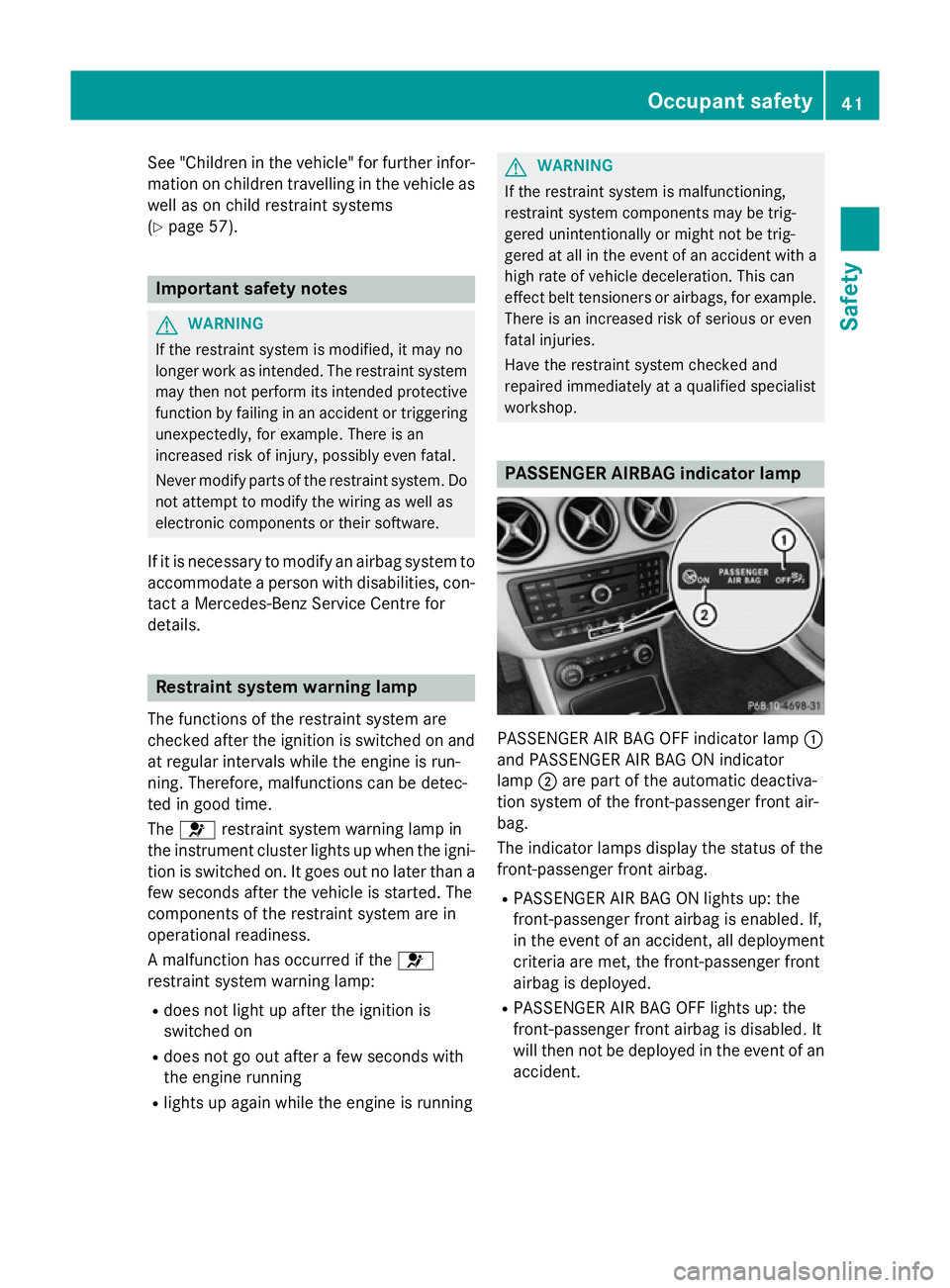
See "Children in the vehicle" for further infor-
mation on children travelling in the vehicle as
well as on child restraint systems
(Y page 57). Important safety notes
G
WARNING
If the restraint system is modified, it may no
longer work as intended. The restraint system
may then not perform its intended protective function by failing in an accident or triggering
unexpectedly, for example. There is an
increased risk of injury, possibly even fatal.
Never modify parts of the restraint system. Do not attempt to modify the wiring as well as
electronic components or their software.
If it is necessary to modify an airbag system to
accommodate a person with disabilities, con- tact a Mercedes-Benz Service Centre for
details. Restraint system warning lamp
The functions of the restraint system are
checked after the ignition is switched on and
at regular intervals while the engine is run-
ning. Therefore, malfunctions can be detec-
ted in good time.
The 6 restraint system warning lamp in
the instrument cluster lights up when the igni- tion is switched on. It goes out no later than afew seconds after the vehicle is started. The
components of the restraint system are in
operational readiness.
A malfunction has occurred if the 6
restraint system warning lamp:
R does not light up after the ignition is
switched on
R does not go out after a few seconds with
the engine running
R lights up again while the engine is running G
WARNING
If the restraint system is malfunctioning,
restraint system components may be trig-
gered unintentionally or might not be trig-
gered at all in the event of an accident with a high rate of vehicle deceleration. This can
effect belt tensioners or airbags, for example. There is an increased risk of serious or even
fatal injuries.
Have the restraint system checked and
repaired immediately at a qualified specialist
workshop. PASSENGER AIRBAG indicator lamp
PASSENGER AIR BAG OFF indicator lamp
:
and PASSENGER AIR BAG ON indicator
lamp ;are part of the automatic deactiva-
tion system of the front-passenger front air-
bag.
The indicator lamps display the status of the
front-passenger front airbag.
R PASSENGER AIR BAG ON lights up: the
front-passenger front airbag is enabled. If,
in the event of an accident, all deployment
criteria are met, the front-passenger front
airbag is deployed.
R PASSENGER AIR BAG OFF lights up: the
front-passenger front airbag is disabled. It
will then not be deployed in the event of an
accident. Occupant safety
41Safety Z
Page 45 of 405
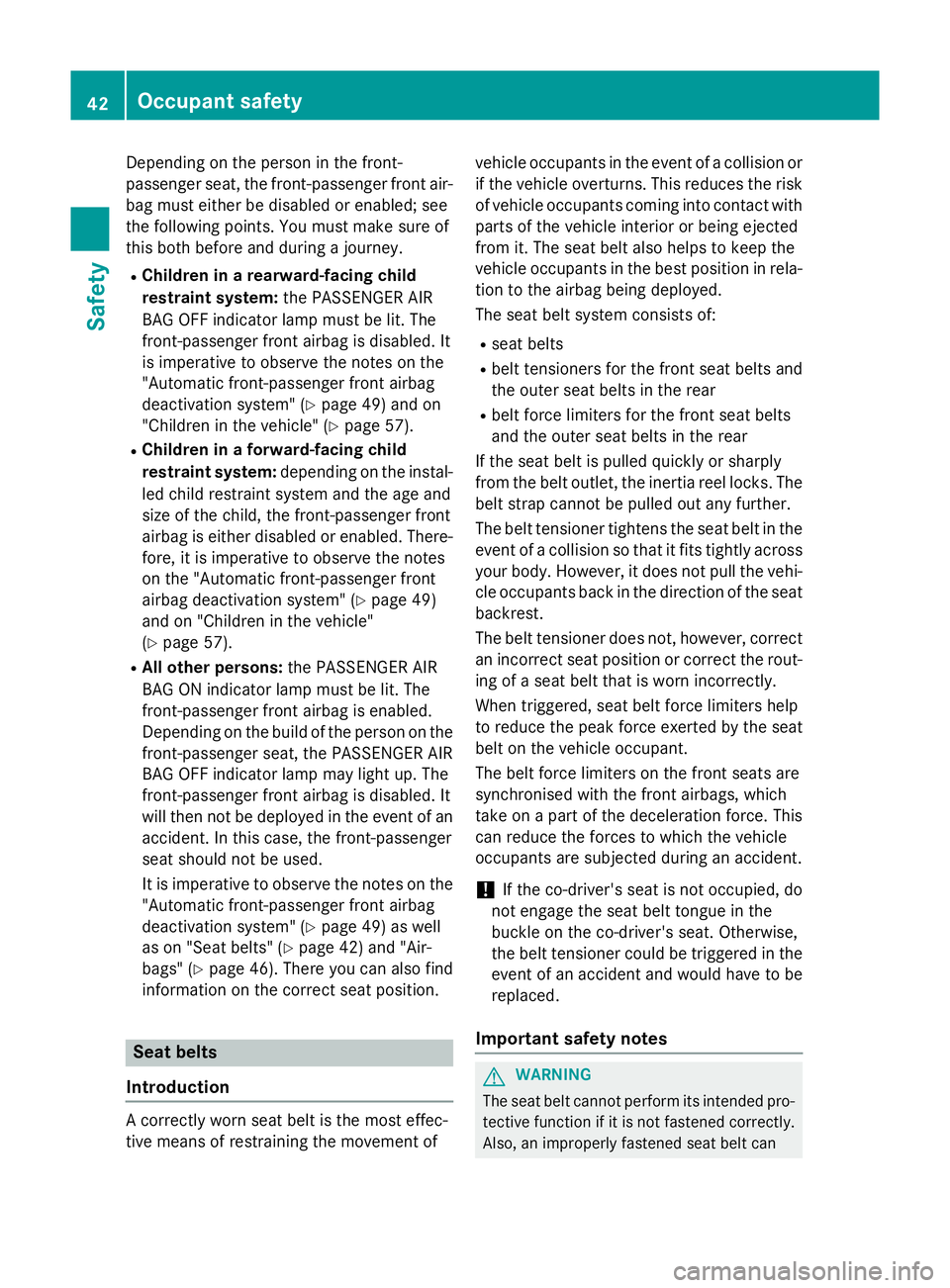
Depending on the person in the front-
passenger seat, the front-passenger front air-
bag must either be disabled or enabled; see
the following points. You must make sure of
this both before and during a journey.
R Children in a rearward-facing child
restraint system: the PASSENGER AIR
BAG OFF indicator lamp must be lit. The
front-passenger front airbag is disabled. It
is imperative to observe the notes on the
"Automatic front-passenger front airbag
deactivation system" (Y page 49) and on
"Children in the vehicle" (Y page 57).
R Children in a forward-facing child
restraint system: depending on the instal-
led child restraint system and the age and
size of the child, the front-passenger front
airbag is either disabled or enabled. There-
fore, it is imperative to observe the notes
on the "Automatic front-passenger front
airbag deactivation system" (Y page 49)
and on "Children in the vehicle"
(Y page 57).
R All other persons: the PASSENGER AIR
BAG ON indicator lamp must be lit. The
front-passenger front airbag is enabled.
Depending on the build of the person on the
front-passenger seat, the PASSENGER AIR
BAG OFF indicator lamp may light up. The
front-passenger front airbag is disabled. It
will then not be deployed in the event of an accident. In this case, the front-passenger
seat should not be used.
It is imperative to observe the notes on the
"Automatic front-passenger front airbag
deactivation system" (Y page 49) as well
as on "Seat belts" (Y page 42) and "Air-
bags" (Y page 46). There you can also find
information on the correct seat position. Seat belts
Introduction A correctly worn seat belt is the most effec-
tive means of restraining the movement of vehicle occupants in the event of a collision or
if the vehicle overturns. This reduces the risk of vehicle occupants coming into contact with
parts of the vehicle interior or being ejected
from it. The seat belt also helps to keep the
vehicle occupants in the best position in rela-
tion to the airbag being deployed.
The seat belt system consists of:
R seat belts
R belt tensioners for the front seat belts and
the outer seat belts in the rear
R belt force limiters for the front seat belts
and the outer seat belts in the rear
If the seat belt is pulled quickly or sharply
from the belt outlet, the inertia reel locks. The belt strap cannot be pulled out any further.
The belt tensioner tightens the seat belt in the
event of a collision so that it fits tightly across
your body. However, it does not pull the vehi- cle occupants back in the direction of the seat
backrest.
The belt tensioner does not, however, correct an incorrect seat position or correct the rout-
ing of a seat belt that is worn incorrectly.
When triggered, seat belt force limiters help
to reduce the peak force exerted by the seat
belt on the vehicle occupant.
The belt force limiters on the front seats are
synchronised with the front airbags, which
take on a part of the deceleration force. This
can reduce the forces to which the vehicle
occupants are subjected during an accident.
! If the co-driver's seat is not occupied, do
not engage the seat belt tongue in the
buckle on the co-driver's seat. Otherwise,
the belt tensioner could be triggered in the
event of an accident and would have to be
replaced.
Important safety notes G
WARNING
The seat belt cannot perform its intended pro- tective function if it is not fastened correctly. Also, an improperly fastened seat belt can 42
Occupant safetySafety
Page 46 of 405
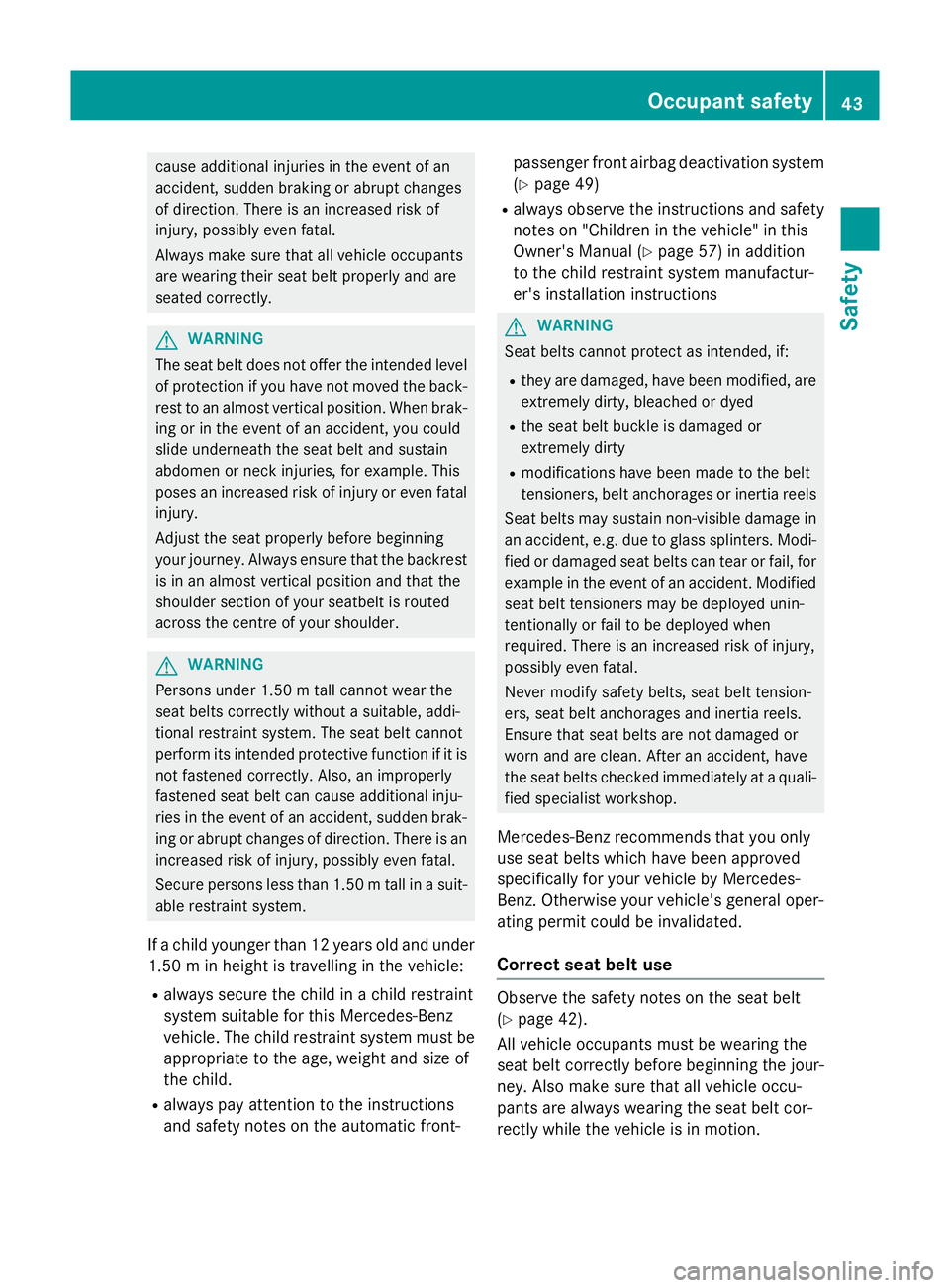
cause additional injuries in the event of an
accident, sudden braking or abrupt changes
of direction. There is an increased risk of
injury, possibly even fatal.
Always make sure that all vehicle occupants
are wearing their seat belt properly and are
seated correctly. G
WARNING
The seat belt does not offer the intended level of protection if you have not moved the back-
rest to an almost vertical position. When brak-
ing or in the event of an accident, you could
slide underneath the seat belt and sustain
abdomen or neck injuries, for example. This
poses an increased risk of injury or even fatal injury.
Adjust the seat properly before beginning
your journey. Always ensure that the backrest
is in an almost vertical position and that the
shoulder section of your seatbelt is routed
across the centre of your shoulder. G
WARNING
Persons under 1.50 mtall cannot wear the
seat belts correctly without a suitable, addi-
tional restraint system. The seat belt cannot
perform its intended protective function if it is not fastened correctly. Also, an improperly
fastened seat belt can cause additional inju-
ries in the event of an accident, sudden brak-
ing or abrupt changes of direction. There is an increased risk of injury, possibly even fatal.
Secure persons less than 1.50 mtall in a suit-
able restraint system.
If a child younger than 12 years old and under 1.50 m in height is travelling in the vehicle:
R always secure the child in a child restraint
system suitable for this Mercedes-Benz
vehicle. The child restraint system must be appropriate to the age, weight and size of
the child.
R always pay attention to the instructions
and safety notes on the automatic front- passenger front airbag deactivation system
(Y page 49)
R always observe the instructions and safety
notes on "Children in the vehicle" in this
Owner's Manual (Y page 57) in addition
to the child restraint system manufactur-
er's installation instructions G
WARNING
Seat belts cannot protect as intended, if:
R they are damaged, have been modified, are
extremely dirty, bleached or dyed
R the seat belt buckle is damaged or
extremely dirty
R modifications have been made to the belt
tensioners, belt anchorages or inertia reels
Seat belts may sustain non-visible damage in an accident, e.g. due to glass splinters. Modi-
fied or damaged seat belts can tear or fail, for example in the event of an accident. Modified
seat belt tensioners may be deployed unin-
tentionally or fail to be deployed when
required. There is an increased risk of injury,
possibly even fatal.
Never modify safety belts, seat belt tension-
ers, seat belt anchorages and inertia reels.
Ensure that seat belts are not damaged or
worn and are clean. After an accident, have
the seat belts checked immediately at a quali- fied specialist workshop.
Mercedes-Benz recommends that you only
use seat belts which have been approved
specifically for your vehicle by Mercedes-
Benz. Otherwise your vehicle's general oper-
ating permit could be invalidated.
Correct seat belt use Observe the safety notes on the seat belt
(Y
page 42).
All vehicle occupants must be wearing the
seat belt correctly before beginning the jour- ney. Also make sure that all vehicle occu-
pants are always wearing the seat belt cor-
rectly while the vehicle is in motion. Occupant safety
43Safety Z
Page 50 of 405
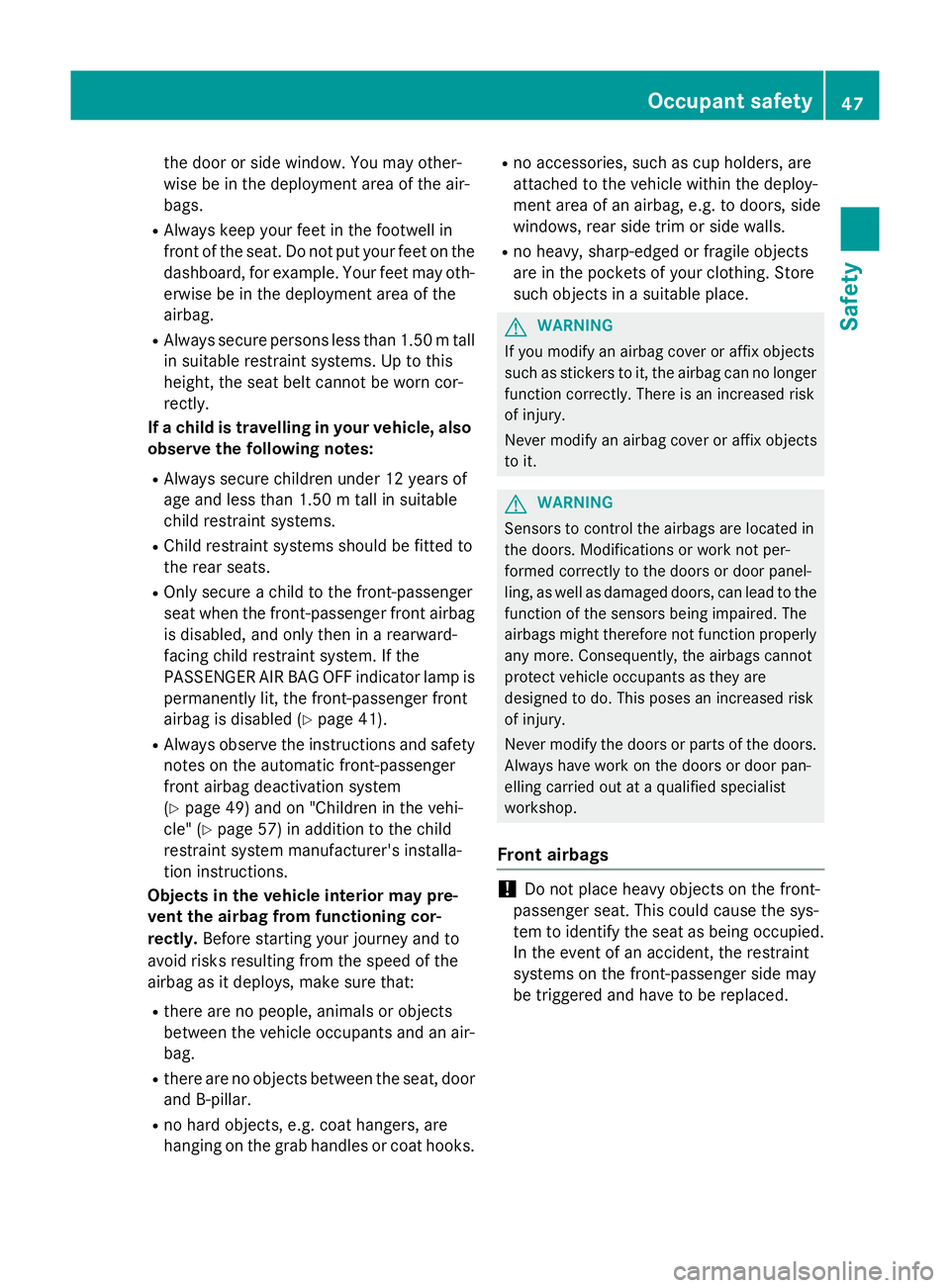
the door or side window. You may other-
wise be in the deployment area of the air-
bags.
R Always keep your feet in the footwell in
front of the seat. Do not put your feet on the
dashboard, for example. Your feet may oth-
erwise be in the deployment area of the
airbag.
R Always secure persons less than 1.50 mtall
in suitable restraint systems. Up to this
height, the seat belt cannot be worn cor-
rectly.
If a child is travelling in your vehicle, also
observe the following notes:
R Always secure children under 12 years of
age and less than 1.50 m tall in suitable
child restraint systems.
R Child restraint systems should be fitted to
the rear seats.
R Only secure a child to the front-passenger
seat when the front-passenger front airbag
is disabled, and only then in a rearward-
facing child restraint system. If the
PASSENGER AIR BAG OFF indicator lamp is
permanently lit, the front-passenger front
airbag is disabled (Y page 41).
R Always observe the instructions and safety
notes on the automatic front-passenger
front airbag deactivation system
(Y page 49) and on "Children in the vehi-
cle" (Y page 57) in addition to the child
restraint system manufacturer's installa-
tion instructions.
Objects in the vehicle interior may pre-
vent the airbag from functioning cor-
rectly. Before starting your journey and to
avoid risks resulting from the speed of the
airbag as it deploys, make sure that:
R there are no people, animals or objects
between the vehicle occupants and an air-
bag.
R there are no objects between the seat, door
and B-pillar.
R no hard objects, e.g. coat hangers, are
hanging on the grab handles or coat hooks. R
no accessories, such as cup holders, are
attached to the vehicle within the deploy-
ment area of an airbag, e.g. to doors, side
windows, rear side trim or side walls.
R no heavy, sharp-edged or fragile objects
are in the pockets of your clothing. Store
such objects in a suitable place. G
WARNING
If you modify an airbag cover or affix objects
such as stickers to it, the airbag can no longer function correctly. There is an increased risk
of injury.
Never modify an airbag cover or affix objects
to it. G
WARNING
Sensors to control the airbags are located in
the doors. Modifications or work not per-
formed correctly to the doors or door panel-
ling, as well as damaged doors, can lead to the function of the sensors being impaired. The
airbags might therefore not function properly any more. Consequently, the airbags cannot
protect vehicle occupants as they are
designed to do. This poses an increased risk
of injury.
Never modify the doors or parts of the doors.
Always have work on the doors or door pan-
elling carried out at a qualified specialist
workshop.
Front airbags !
Do not place heavy objects on the front-
passenger seat. This could cause the sys-
tem to identify the seat as being occupied.
In the event of an accident, the restraint
systems on the front-passenger side may
be triggered and have to be replaced. Occupant safety
47Safety Z
Page 52 of 405
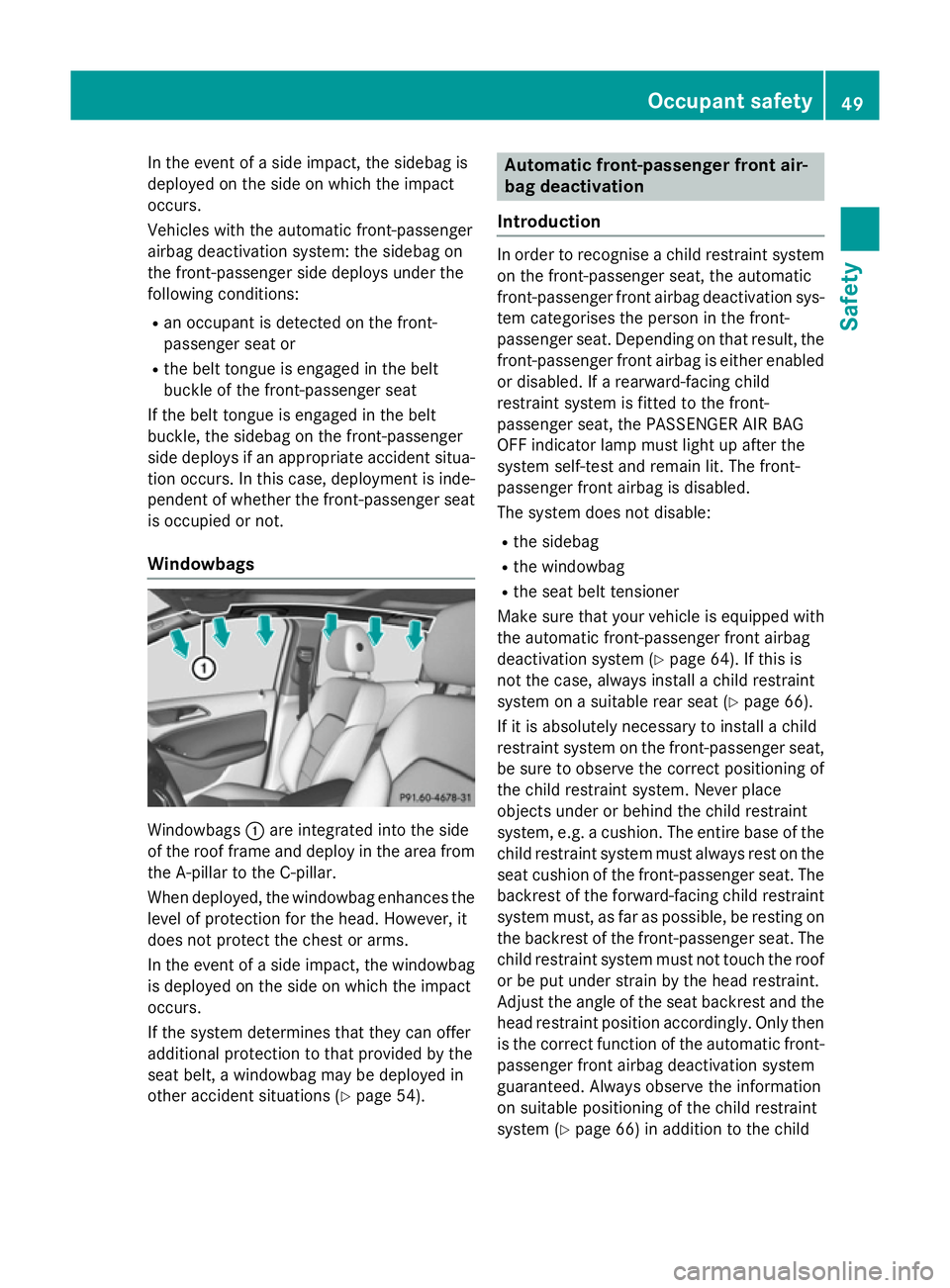
In the event of a side impact, the sidebag is
deployed on the side on which the impact
occurs.
Vehicles with the automatic front-passenger
airbag deactivation system: the sidebag on
the front-passenger side deploys under the
following conditions:
R an occupant is detected on the front-
passenger seat or
R the belt tongue is engaged in the belt
buckle of the front-passenger seat
If the belt tongue is engaged in the belt
buckle, the sidebag on the front-passenger
side deploys if an appropriate accident situa- tion occurs. In this case, deployment is inde- pendent of whether the front-passenger seat
is occupied or not.
Windowbags Windowbags
:are integrated into the side
of the roof frame and deploy in the area from
the A-pillar to the C-pillar.
When deployed, the windowbag enhances the level of protection for the head. However, it
does not protect the chest or arms.
In the event of a side impact, the windowbag
is deployed on the side on which the impact
occurs.
If the system determines that they can offer
additional protection to that provided by the
seat belt, a windowbag may be deployed in
other accident situations (Y page 54). Automatic front-passenger front air-
bag deactivation
Introduction In order to recognise a child restraint system
on the front-passenger seat, the automatic
front-passenger front airbag deactivation sys- tem categorises the person in the front-
passenger seat. Depending on that result, the
front-passenger front airbag is either enabled or disabled. If a rearward-facing child
restraint system is fitted to the front-
passenger seat, the PASSENGER AIR BAG
OFF indicator lamp must light up after the
system self-test and remain lit. The front-
passenger front airbag is disabled.
The system does not disable:
R the sidebag
R the windowbag
R the seat belt tensioner
Make sure that your vehicle is equipped with
the automatic front-passenger front airbag
deactivation system (Y page 64). If this is
not the case, always install a child restraint
system on a suitable rear seat (Y page 66).
If it is absolutely necessary to install a child
restraint system on the front-passenger seat,
be sure to observe the correct positioning of
the child restraint system. Never place
objects under or behind the child restraint
system, e.g. a cushion. The entire base of the
child restraint system must always rest on the seat cushion of the front-passenger seat. The
backrest of the forward-facing child restraint
system must, as far as possible, be resting on the backrest of the front-passenger seat. The
child restraint system must not touch the roof or be put under strain by the head restraint.
Adjust the angle of the seat backrest and the
head restraint position accordingly. Only then is the correct function of the automatic front- passenger front airbag deactivation system
guaranteed. Always observe the information
on suitable positioning of the child restraint
system (Y page 66) in addition to the child Occupant safety
49Safety Z